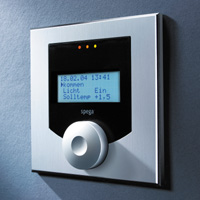
Home automation or domotics is building automation for a home, called a smart home or smart house. A home automation system will monitor and/or control home attributes such as lighting, climate, entertainment systems, and appliances. It may also include home security such as access control and alarm systems. When connected with the Internet, home devices are an important constituent of the Internet of Things ("IoT").
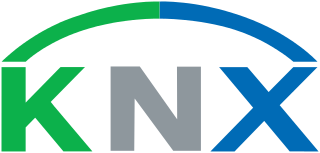
KNX is an open standard for commercial and residential building automation. KNX devices can manage lighting, blinds and shutters, HVAC, security systems, energy management, audio video, white goods, displays, remote control, etc. KNX evolved from three earlier standards; the European Home Systems Protocol (EHS), BatiBUS, and the European Installation Bus.
Zigbee is an IEEE 802.15.4-based specification for a suite of high-level communication protocols used to create personal area networks with small, low-power digital radios, such as for home automation, medical device data collection, and other low-power low-bandwidth needs, designed for small scale projects which need wireless connection. Hence, Zigbee is a low-power, low data rate, and close proximity wireless ad hoc network.
C-Bus or Cbus may refer to:
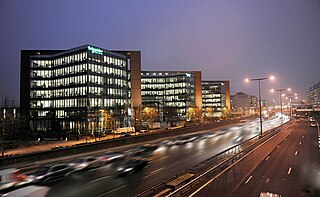
Schneider Electric SE is a French multinational company that specializes in digital automation and energy management. It addresses homes, buildings, data centers, infrastructure and industries, by combining energy technologies, real-time automation, software, and services.
A fieldbus is a member of a family of industrial digital communication networks used for real-time distributed control. Fieldbus profiles are standardized by the International Electrotechnical Commission (IEC) as IEC 61784/61158.

APC by Schneider Electric is a manufacturer of uninterruptible power supplies, electronics peripherals, and data center products.
Clipsal is an Australian brand of electrical accessories. Their primary factory, once located at Bowden, moved to Gepps Cross, South Australia. Smaller factories in South Australia at Nuriootpa, Strathalbyn, Wingfield, Bayswater and in Victoria have closed and production has moved to Gepps Cross and to offshore locations. From 2000 to 2017, Clipsal was the naming rights sponsor for the Adelaide 500 Supercars race.
Building automation(BAS), also known as building management system (BMS) or building energy management system (BEMS), is the automatic centralized control of a building's HVAC (heating, ventilation and air conditioning), electrical, lighting, shading, Access Control, Security Systems, and other interrelated systems. Some objectives of building automation are improved occupant comfort, efficient operation of building systems, reduction in energy consumption, reduced operating and maintaining costs and increased security.

A lighting control system is an intelligent network based lighting control solution that incorporates communication between various system inputs and outputs related to lighting control with the use of one or more central computing devices. Lighting control systems are widely used on both indoor and outdoor lighting of commercial, industrial, and residential spaces. Lighting control systems are sometimes referred to under the term smart lighting. Lighting control systems serve to provide the right amount of light where and when it is needed.
Dynalite is a lighting and automation control system developed in Sydney, Australia by a company of the same name. In 2009 the company was bought by Philips to become Philips-Dynalite. The system is commonly used for lighting control, building automation, home automation and room automation applications and is sold worldwide.
Universal Powerline Bus (UPB) is a proprietary software protocol developed by Powerline Control Systems for power-line communication between devices used for home automation. Household electrical wiring is used to send digital data between UPB devices via pulse-position modulation.
C-Bus is a communications protocol based on a seven layer OSI model for home and building automation that can handle cable lengths up to 1000 metres using Cat-5 cable. It is used in Australia, New Zealand, Asia, the Middle East, Russia, United States, South Africa, the UK and other parts of Europe including Greece and Romania. C-Bus was created by Clipsal Australia's Clipsal Integrated Systems division for use with its brand of home automation and building lighting control system. C-Bus has been briefly available in the United States but Schneider Electric has now discontinued sales in the United States.
PLCBUS or PLC-BUS is a power-line communication protocol for communication between electronic devices used for home automation. It primarily uses power line wiring for signaling and control.
MelsecNet is a protocol developed and supported by Mitsubishi Electric for data delivery. MelsecNet supports 239 networks.
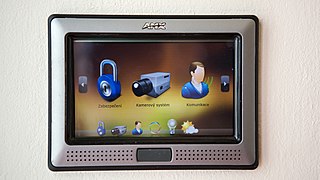
This is a list of home automation topics on Wikipedia. Home automation is the residential extension of building automation. It is automation of the home, housework or household activity. Home automation may include centralized control of lighting, HVAC, appliances, security locks of gates and doors and other systems, to provide improved convenience, comfort, energy efficiency and security.
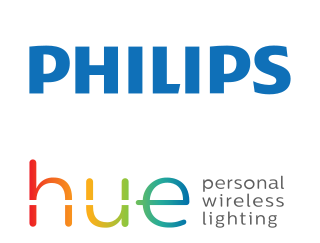
Philips Hue is a line of color-changing LED lamps and white bulbs which can be controlled wirelessly. The Philips Hue line of bulbs was the first smart bulb of its kind on the market. The lamps are currently created and manufactured by Signify N.V., formerly the Philips Lighting division of Royal Philips N.V.

Matter, formerly Project Connected Home over IP (CHIP), is a proprietary standard for home automation that is royalty-free, with manufacturers only incurring certification costs. Announced on 18 December 2019, Matter aims to reduce fragmentation across different vendors, and achieve interoperability among smart home devices and Internet of things (IoT) platforms from different providers. The project group was launched and introduced by Amazon, Apple, Google, Comcast and the Zigbee Alliance, now Connectivity Standards Alliance (CSA). Subsequent members include IKEA, Huawei, and Schneider. Matter-compatible software updates for many existing hubs became available in late 2022, with Matter-enabled devices and software updates expected to be released during 2023.
A smart home hub, sometimes also referred to as a "smart hub", "gateway'", "bridge", "controller" or "coordinator", is a control center/centre for a smart home, and enables the components of a smart home to communicate and respond to each other via communication through a central point. The smart home hub can consist of dedicated computer appliance, software appliance, or software running on computer hardware, and makes it possible to gather configuration, automation and monitoring of a smart house by communicating and controlling different smart devices that consist of for example home appliances, sensors and relays or robots, many of which are commonly categorized under Internet of things.







